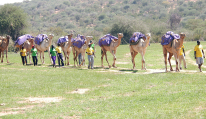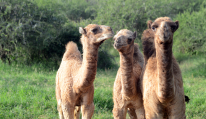Range & Habitat
Camels are specially adapted to living in the arid and semiarid regions of Africa. Many live on farms and ranches while others range freely, but under the control of herdsmen.
Camels have adapted to dry habitats with extreme conditions. Camels are famed for their ability to withstand periods of drought and to rehydrate quickly. (They don’t do well in wet, muddy areas.) Their thick, coarse lips enable them to eat thorny plants other animals cannot. Their large, soft padded feet enable them to walk easily on shifting sand or over rocks. Double rows of long eyelashes protect their eyes from blowing dust and sand, and their nostrils close to keep out the same.













